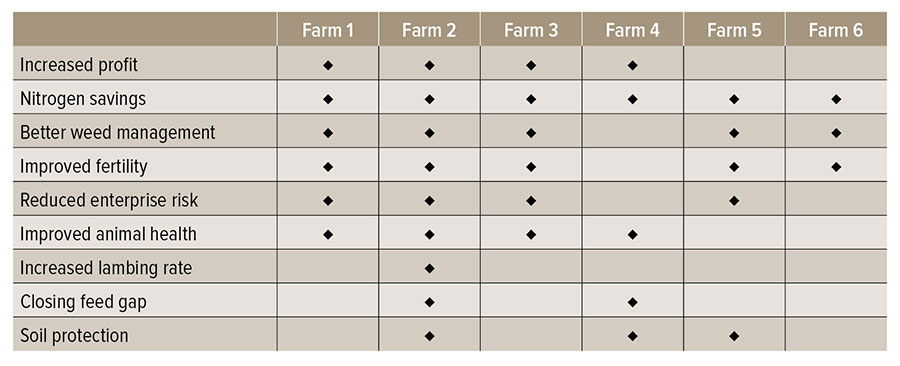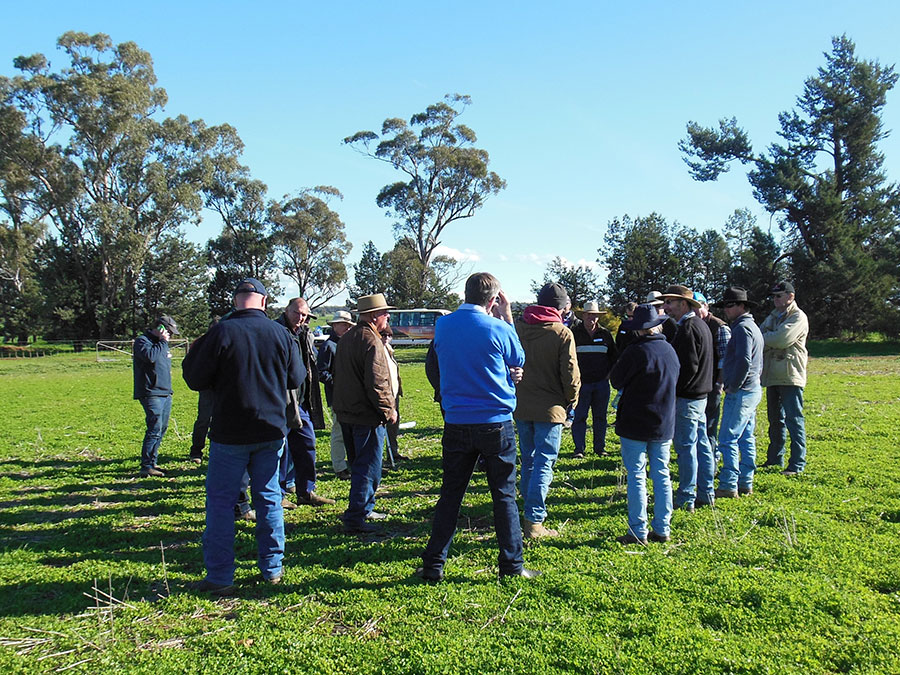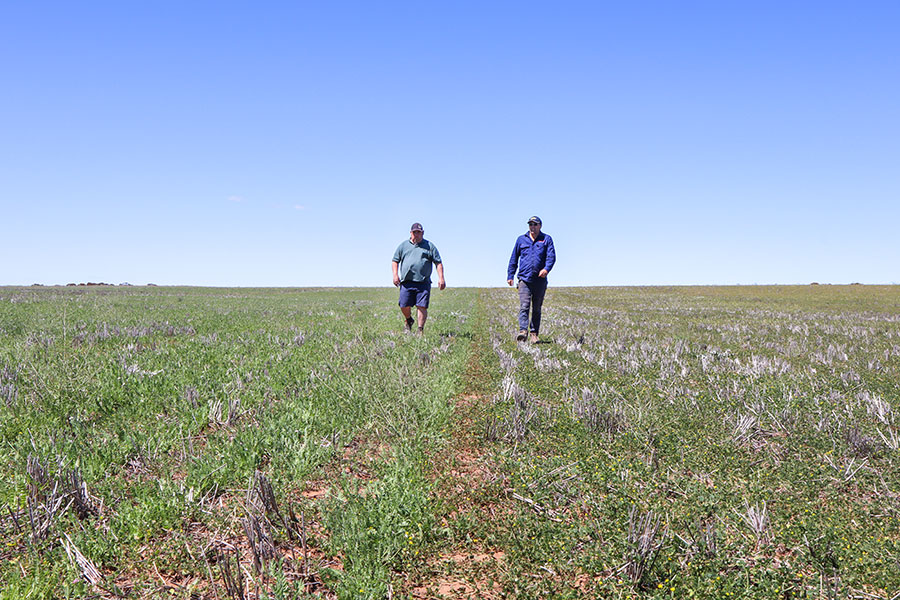Lack of diversity in farming systems in the low to medium-rainfall regions of Australia is problematic as most growers rely heavily on chemical inputs to manage weeds and nitrogen supplies, and soil organic matter levels decline. The lack of diversity also creates economic, seasonal and other risks.
However, identification and development of novel hard-seeded pasture legumes, teamed with cost-reducing management practices and supported by dedicated extension efforts, are heralding a revolutionary change for these regions.
RD&E support
Growers in dry regions with between 250 and 450 millimetres of annual rainfall, have long been seeking new types of crops and pastures to diversify their businesses, and recent good returns from stock and high fertiliser prices are encouraging a rethink, especially on the role of legumes.
To address this issue, there has been a long but slightly patchy history of investment in legume pasture development in Australia through the Centre for Legumes in Mediterranean Agriculture and the National Annual Pasture Legume Improvement Program, with investment from various industry organisations including GRDC, Meat & Livestock Australia (MLA) and Australian Wool Innovation (AWI).
More recently, the Dryland Legume Pasture Systems (DLPS) project worked for five years (2017–22) in four states with investment from the Australian Government Department of Agriculture, Water and the Environment as part of its Rural R&D for Profit program, GRDC, MLA and AWI.
Working across these research initiatives has been a core group of dedicated research and extension experts and growers, with their eyes firmly fixed on a shared vision for hardy pasture legumes within mixed cropping systems to benefit both crop and animal profitability.
They focused their efforts on legume species that are aerial seeders – features which enable them to be harvested on-farm. Combined with twin or summer sowing, a small amount of seed can be established across the farm at minimal cost.
The hard-seeded varieties provide ‘legumes on demand’ that regenerate from the seedbank in the soil, after one or more years of cropping. This is possible because the hard-seed breakdown patterns of the varieties enable them to persist for many years and provide growers with the flexibility to choose when to allow the legume pasture to grow in response to market signals and seasonal conditions.
There are many lasting benefits of these novel species, including increased agility in the choice of crop or pasture production, and the production of a highly nutritious forage for livestock with the potential to reduce methane and greenhouse gas emissions for meat and wool production systems. Also, these legumes increase nitrogen fixation in the farming system, reduce the need for fertiliser inputs and boost grain yield and protein contents in following crops.
The portfolio of species now includes serradella (Ornithopus spp.), biserrula (Biserrula pelecinus), bladder clover (Trifolium spumosum) and gland clover (Trifolium glanduliferum). A release of Trigonella balansae is also expected in coming years, which will complement several new releases of annual medic for the alkaline soils.
The DLPS supported legume pasture research at Murdoch University, the South Australian Research and Development Institute (SARDI), CSIRO, the Western Australian Department of Primary Industries and Regional Development (DPIRD), and New South Wales Department of Primary Industries (DPI).
Key to the direction of the research and extension and adoption of the outputs was engagement with grower groups across Australia. These groups helped direct the research, raised program awareness, established demonstration sites, measured regional pasture benefits and extended the findings within their networks. They included Mingenew Irwin Group (MIG), Corrigin Farm Improvement Group (CFIG), ASHEEP Esperance, Agricultural Innovation and Research Eyre Peninsula, Upper North Farming Systems, Mallee Sustainable Farming, EPAG Research, Frontier Farming Systems, Birchip Cropping Group and Central West Farming Systems.
Forty-eight demonstration sites were established across the program. While COVID-19 restrictions curtailed the number of field site visits and workshops delivered in some states, more than 9000 adviser/grower interactions occurred. About 500 growers were estimated to have sown new pasture areas as a result of the work.
Early adopters of the legumes in each region have become champions for the new legumes, sharing their experiences and management practices with other growers.
An independent national survey of 400 mixed-farming growers in the low-rainfall zone was commissioned by CSIRO on behalf of the program. Results are still being collated but will quantify current levels of adoption (including DLPS impacts), as well as understand barriers and future drivers of adoption to direct further pasture development.
Western component
DPIRD research scientist Dr Angelo Loi is a pasture legume industry stalwart in WA. He hails from Sardinia Island in the Mediterranean where, coincidently, many of the new legume species introduced to Australia are natives. Dr Loi has spent the last 20 years investigating the complexity of Australian farming systems and improving their sustainability, especially with pasture legumes.
“The DLPS fostered national collaboration which enabled us to take the RD&E on these new pasture legume species to the next level for Australian growers,” Dr Loi says.
“Together with colleagues at Murdoch University and CSIRO, we were able to further exploit the unique features of the species under development prior to the DLPS. The national project enabled us to improve their management and to better quantify their benefits for animal and crop production within mixed-farming systems.
“This considered the rotational effects in terms of residual nitrogen, weed and disease levels, and also extending to integrating grazing and testing nutritional benefits for livestock.
“A bio-economic modelling effort led by CSIRO was a real value-add as we generated sufficient calibration data to test various scenarios within different farming systems and seasons. These predictions are an invaluable decision aid for growers.”
Dr Loi estimates that between 20,000 to 40,000 hectares will be sown to the new serradella variety Fran2o across WA’s low to medium-rainfall regions in 2022, plus expansion into NSW.
As an extension specialist, Dr Loi says the DLPS was very rewarding work.
“Farmers in the dry areas of WA clearly had a diversity problem which added risk to their farming system, and once this was acknowledged, we were able to implement improvements by introducing new pasture species, and ramp things up when growers had confidence to really exploit the new system.”
Dr Loi worked closely with a small group of growers who were early adopters of the new species. “This exercise enabled us to ground-truth both the new species and establishment techniques, collect information on the barriers to adoption and benefits of including them in mixed-farming systems.
“This co-learning approach gave growers the confidence to try a new system that is potentially a game changer for them. This created information to support the benefits of the new species and sowing systems for further extension, and also encouraged growers to champion the changes to other growers.”
Table 1: Benefits identified by early-adopters for their properties from the low-medium rainfall region of WA of adopting novel pasture legumes and summer sowing techniques.

Source: DPIRD
Anna-Lisa and Craig Newman at Varley in WA were involved in the DLPS and supported by Dr Loi in a large-scale pasture renovation project.
“We had invested in more land to expand our mixed-farming business to 8300ha, but the poor pastures were in need of renovation. We were given information and confidence by the DLPS to make an ambitious plan to do this,” Anna-Lisa says.
“The scale of what we have achieved, mainly using serradellas and biserrula, is extensive – especially in a low-rainfall region – but for us it coincided with purchasing run-down farms needing a break from cropping, and we were still building sheep numbers so we could push the envelope. However, given it’s a low-rainfall zone and 2019 and 2020 were decile-one years, it was quite a test for the novel species and they did exceptionally well.
“We have invested capital upfront to establish the system but are seeing the benefits flow back into the system now. It is still relatively early days but we are hoping to see the trend in our productivity and profitability continue upward as the need for nitrogen fertiliser decreases and soil health improves.”

Robert Harrison, CSIRO, presenting to growers one of the new Trigonella balansae varieties during the A-sheep field day October 2021. Photo: Angelo Loi, DPIRD
Dr Loi is a staunch advocate for ‘seeing is believing’ as an extension and adoption tool. “Pasture tours and field walks conducted through the project were a perfect means to demonstrate to growers what could be achieved with the new legume species,” he says.
The findings of the project within WA were communicated to more than 6500 people, with numerous presentations, field days, farm visits and phone inquiries each year, mainly in districts serviced by MIG, CFIG and ASHEEP. However, project members presented throughout the WA wheat/sheep belt and, importantly, organised five pasture tours throughout regions for growers, researchers and advisers.
NSW component
In the low to medium-rainfall regions of central and southern NSW, growers have been on the hunt for more-productive pasture legumes to complement and – in some cases – replace lucerne, and reduce the incidence of bloat in livestock.
Indomitable NSW DPI pasture agronomist Dr Belinda Hackney managed the northern component of the DLPS.
“Grower involvement in the DLPS was critical to its success,” Dr Hackney says.
“From representatives on the project steering committee to growers hosting trial and demonstration sites, their participation created a sense of ownership in the project and we learnt together and ground-truthed the results in paddocks as we went.
“Growers told us if management aspects would not work for them and we also actively surveyed growers as we went to identify needs and limitations.”

Growers learning from growers about new hard-seeded pasture legumes in a bladder and gland clover mixed pasture that has regenerated after a cropping phase at a field day at Mike O’Hare’s Beckom property, NSW 2020. Photo: Dr Belinda Hackney, NSW DPI.
Dr Hackney encourages ‘testing before investing’ with the novel legume species.
“A great way for growers to identify which species perform best on their properties was to purchase small amounts of seed of several of the new varieties and establish small nursery paddocks.
“Favourable species can then be harvested with conventional headers and sown in other paddocks.”
With Dr Hackney’s support, Paul Sinderberry and Sarah Wrigley trialled a number of new legume species in test strips on their 11,000ha mixed-farming enterprise north of Condobolin.
“We were on the hunt for legume species that had less bloat risk for our cattle enterprise and set up trial strips of a number of species, including biserrula and serradella, which were known to have lower bloat risk,” Paul says.
“We found the trial strips a really valuable exercise as we saw what was best-adapted to our red sandy clay loams that have a pHCa of between 4.5 and 5.5 and low phosphorus. Although our annual rainfall is around 420mm we experienced several years of drought during the test time and we were amazed at the seed set and regrowth of biserrula after drought.”
Paul has learnt from local growers how to best harvest biserrula on-farm and has expanded his biserrula area, mixing it with lucerne to lower bloat risk, and is beginning to introduce it into his cropping sequences.
COVID-19 restrictions in NSW forced a pivot for the extension program and, fortunately, Dr Hackney was well-supported by colleagues to move to delivering webinars and generating podcasts and videos.
“Although not my preferred method, these forms of extension have created legacy information for the DLPS,” she says.
Overall, more than 5000 growers and consultants were reached through the NSW DPI extension program over the course of the DLPS.
“Over the life of the project 3500ha Fran2o (PBR), 20,000ha biserrula and 40,000ha of the aerial-seeding clovers were sown across the low to medium-rainfall region of NSW.”
Dr Hackney says they have received many requests for a production manual for these new species, which they are working on, with an anticipated release in early 2023.
Southern component
The southern pasture development component was led by seasoned rhizobiologist Ross Ballard and annual pasture legume breeder David Peck (SARDI). Bonnie Flohr (CSIRO) and Michael Moodie (Frontier Farming Systems) focused on measuring the benefits pastures provide.
Nineteen demonstration trials were established in SA and Victoria over the course of the DLPS.
Although COVID-19 curtailed some of the extension activities planned in the southern component, more than 2400 grower/adviser interactions occurred with the SA/Victorian team over the five years. Numerous presentations were provided across a range of forums including GRDC Updates, grower/agronomist meetings, trial and demonstration site visits and conferences.
Extensive cooperation has been key to the extension and adoption activities of the DLPS including with SARDI’s seed industry partners, to raise awareness of pending releases and encourage the adoption and optimum management of new and existing pasture varieties. Adoption area of new legumes in SA/Victoria to date is estimated to be more than 20,000ha.
Mr Ballard credits the early adoption of the new strand medic (Medicago littoralis) Seraph to the exposure it was given to growers through the DLPS.
“Seraph was bred by SARDI to be resistant to powdery mildew and tolerant to sulfonylurea herbicide residues, making it very useful in southern cropping rotations. Through CSIRO modelling, we are predicting it could be adopted on 200,000ha by 2030,” Mr Ballard says.
Michael Moodie from Frontier Farming Systems oversaw several of the field trials on growers’ properties in the south, including large strip trials at Scott Anderson’s property at Ouyen in Victoria.
“The DLPS has been great for identifying soil types and farming systems that could benefit from the adoption of the new pasture legume species,” Mr Moodie says.

Michael Moodie (left) and Scott Anderson (right) walking large strip trials of Fran2o serradella (right) and Seraph medic on Scott Andersons’ mixed farm at Ouyen, Victoria. Photo: Stacey Solomon, Frontier Farming Systems
“In this region legumes such as pulses and vetch have become common place on the better soil types, however, growers are still looking for a legume with improved production on more challenging soils such as deep sands. It is a significant change for growers to consider new species that may have different roles in their farming systems.”
In this respect Mr Moodie says there may be instances where pasture legumes may be more robust than pulses. For example, serradella could have a niche as an alternative to lupins in the deep sands of the region, especially as serradella share the same rhizobium group as lupins.
“Using serradella together with the twin sowing technique may offer operational ease for growers and reduce erosion by providing soil cover over summer and avoiding another sowing operation to establish pasture in the next season.”
“But this is a big change in farming systems thinking and growers require on-going support to make it happen.”
Learnings and legacy
Professor John Howieson from Murdoch University is a long-time champion of pasture legumes, having led many components of previous research.
“We know that subclovers and medics hitchhiked their way to Australia and we have effectively farmed these incidental pasture species for a century or more. Although they have served us well, we have learnt through various research initiatives and experience that the legumes are not nearly as broadly adapted as cereals,” Professor Howieson says.
“There are niches for a range of pasture legumes. It has been a matter of defining these niches, matching the best legume and exploiting them to improve productivity.

Professor John Howieson with a bulk up plot of Trigonella balansae. Photo: Anvil Media
“Over the years we have collected species, together with rhizobia, that are better suited to Australian environments, and then we have worked with growers to fine-tune them to our farming systems, which have also changed over time.
“Matching new hard-seeded pasture legumes with innovative sowing techniques and the ability to harvest with conventional machinery has been a revolution for Australian growers, especially in dry areas.
“One of the defining outputs and significant learnings from the DLPS has been quantifying the rotational benefit of these species in different environments in terms of the nitrogen they can contribute.
“Legacies from the DLPS include both the knowledge we have generated and the new legume varieties we have released or are soon to be released, including Fran2o serradella, a new yellow serradella, a Trigonella balansae, a new bladder clover and Seraph medic.
“The power of the DLPS has been bringing together a diverse, multidisciplinary team and co-learning with growers. The project has provided great opportunities for researchers to learn how new knowledge from complementary disciplines may be applied to existing problems and lead to the development of innovative solutions.”
To build on the success of the DLPS, Professor Howieson says, it is important for the industry to educate the next generation of pasture scientists.
More information: Stephen Loss, Stephen.Loss@grdc.com.au
GoundCover Supplement - Dryland Legume Pasture Systems: a new era for mixed farms.

























































